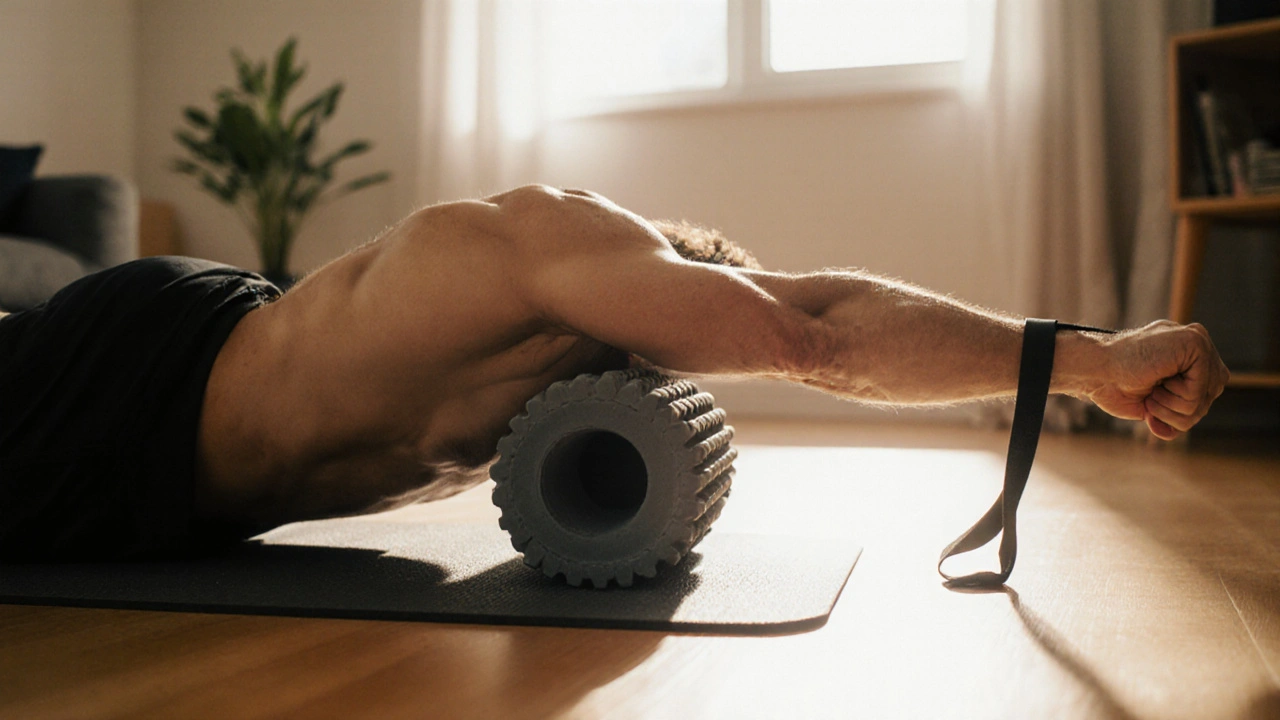Fascia Stretching for Holistic Health: Benefits, Techniques & Tips
 Oct, 7 2025
Oct, 7 2025
Fascia Stretching Routine Planner
Plan Your Daily Fascia Routine
Your Personalized Fascia Routine
Recommended for holistic health and improved mobility.
When you hear "stretching," you probably picture a quick hamstring bend before a run. What if the real game‑changer is the invisible web that surrounds every muscle, bone, and organ? Fascia stretching targets that web, unlocking mobility, easing pain, and fitting perfectly into a holistic health routine.
Key Takeaways
- Fascia is a continuous connective tissue network that influences posture, movement, and even emotions.
- Regular fascia stretching improves blood flow, reduces adhesions, and supports overall wellbeing.
- Techniques like foam rolling, dynamic fascia stretches, and myofascial release can be done in under 15 minutes a day.
- Integrating fascia work with yoga, Pilates, or everyday activities boosts long‑term mobility.
- Avoid common errors such as overstretching cold tissue and neglecting breath.
Understanding Fascia
Fascia is a thin, tough, but flexible layer of connective tissue that wraps around muscles, bones, nerves, and organs, forming a body‑wide net. It not only provides structural support but also communicates mechanical tension throughout the system.
Because fascia links every part of the body, a restriction in the shoulder can affect the lower back, and a tight calf can influence breathing patterns. This interconnection is why many holistic practitioners treat fascia as the missing link between physical health and emotional balance.

Why Fascia Stretching Matters in Holistic Health
Holistic health looks at the whole person-body, mind, and spirit. Fascia stretching fits that philosophy in three ways:
- Physical integration: By smoothing out adhesions, fascia stretching restores natural movement patterns, reducing compensations that lead to injury.
- Neurological benefit: Gentle fascia work stimulates the fascial proprioceptors, calming the nervous system and lowering cortisol levels.
- Emotional release: Many practitioners report that releasing fascial tension also eases emotional holding, aligning with the mind‑body connection emphasized in holistic approaches.
Research from the International Journal of Sports Medicine (2023) found that participants who added a 10‑minute fascia routine to their regular workout experienced a 12% increase in range of motion and a 15% drop in perceived stress.
Core Fascia Stretching Techniques
Below are five foundational techniques that cover most of the body. Perform each after a light warm‑up or at the end of a yoga flow.
- Foam Roller Myofascial Release
Lie on a foam roller and gently roll over tight spots for 30-60 seconds. Focus on the quadriceps, IT band, and upper back. Keep breathing deep to signal the tissue to relax.
- Dynamic Fascia Stretch (Spinal Wave)
Stand tall, hinge at the hips, and let your torso sway side‑to‑side like a wave. Move slowly for 1 minute, allowing the spine’s fascia to glide. This motion promotes fluid circulation through the spinal connective tissue layers.
- Band‑Assisted Fascia Pull
Loop a resistance band around the forearm, extend the arm forward, and gently pull the band away to create a mild traction on the forearm fascia. Hold for 20 seconds, then repeat on the opposite side.
- Trigger Point Release with a Ball
Place a lacrosse ball under the gluteal region or plantar foot, and apply steady pressure for 45 seconds. This targets trigger points that often tether fascia.
- Gentle Yoga‑Style Fascia Flow
Integrate a short sequence-Cat‑Cow, Downward Dog, and a seated forward fold-focusing on fluid movement rather than deep static holds. The continuous flow respects fascia’s need for glide, not static stretch.
Integrating Fascia Stretching into a Daily Routine
Consistency beats intensity when it comes to fascia. Here’s a simple schedule that blends with typical life patterns:
- Morning (5min): Dynamic Fascia Stretch while brushing teeth or waiting for coffee.
- Midday (10min): Foam roller session at the desk or a quick band‑assisted pull during a break.
- Evening (10min): Yoga‑style flow followed by trigger point release before bed.
Pair these stretches with mindful breathing or a short meditation to amplify the holistic impact. When the nervous system is calm, fascia responds more readily to lengthening.

Common Mistakes & How to Avoid Them
Even well‑meaning practitioners can slip up. Spot the pitfalls below and correct them fast:
| Aspect | Fascia Stretching | Static Stretching | Dynamic Stretching |
|---|---|---|---|
| Primary Goal | Restore glide & reduce adhesions | Increase muscle length | Prepare muscles for activity |
| Typical Duration | 10‑15min daily | 30‑60sec per muscle | 5‑10min pre‑exercise |
| Best Time | Any time, especially when body is warm | After warm‑up or workout | Before workout |
| Effect on Nervous System | Calming, reduces stress hormones | Neutral or slightly activating | Activating, raises heart rate |
Key errors to watch:
- Stretching cold tissue: Fascia is less pliable when cold, increasing injury risk. Warm up with light cardio or a gentle dynamic wave first.
- Holding too hard: Fascia responds to gentle pressure. Pain beyond mild discomfort signals you’re over‑doing it.
- Ignoring breath: Breath acts as a nervous‑system reset. Skip it and you’ll miss the relaxation benefit.
- One‑size‑fits‑all routines: Everyone’s fascial patterns differ. Tailor stretches to your body’s specific tight spots.
Next Steps & Troubleshooting
If you feel stiffness after a week, try these adjustments:
- Increase session length by 2‑3 minutes, focusing on the area that feels tight.
- Incorporate a warm‑up like marching in place for 2 minutes before fascia work.
- Experiment with different tools-swap a foam roller for a textured massage ball to change pressure patterns.
- Track progress in a simple log: note date, technique, duration, and how you felt. Patterns will reveal what works best.
Remember, fascia adapts slowly. Consistent, mindful practice yields the best holistic results.
Frequently Asked Questions
Can I do fascia stretching if I have a chronic injury?
Yes, but start gently. Use light foam‑roller rolls or a soft ball for 20‑30 seconds per spot, and avoid any sharp pain. Pair the work with advice from a physiotherapist familiar with myofascial therapy.
How often should I practice fascia stretching?
Aim for 3‑5 short sessions a week. Even a 5‑minute daily routine keeps fascia hydrated and mobile.
Is fascia stretching the same as yoga?
Yoga includes fascia work, but it also adds breath, meditation, and specific poses. Pure fascia stretching focuses on glide and release, often using tools like rollers or bands.
What’s the difference between myofascial release and fascia stretching?
Myofascial release is a hands‑on technique that applies sustained pressure to break up adhesions. Fascia stretching combines that pressure with movement, targeting both length and glide.
Do I need expensive equipment?
No. A simple foam roller, a resistance band, or even a tennis ball works fine. The key is consistency, not cost.
